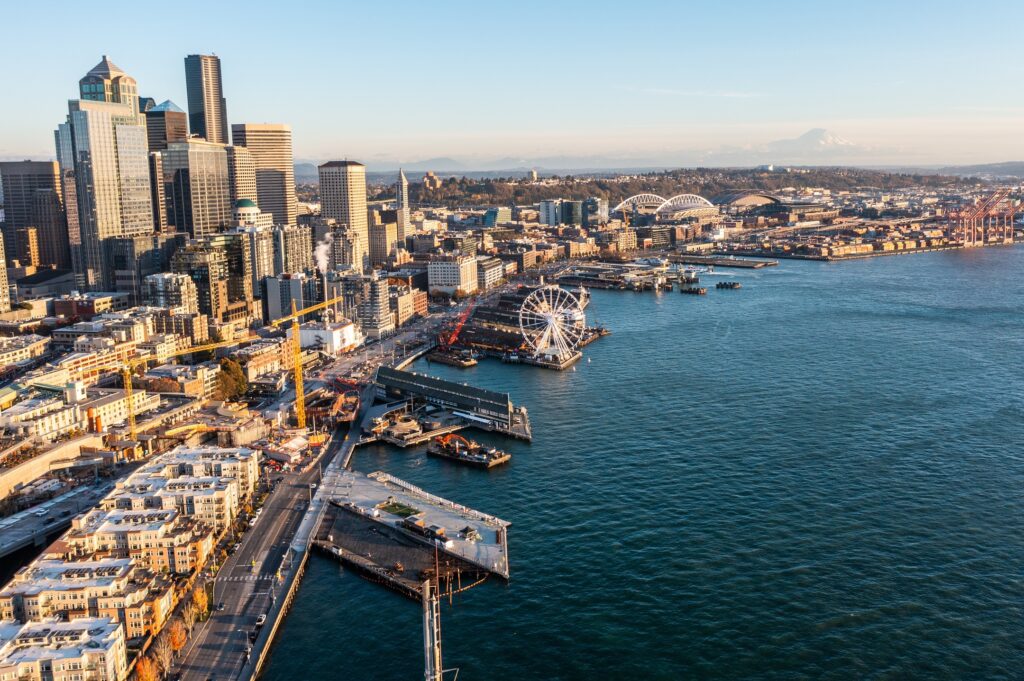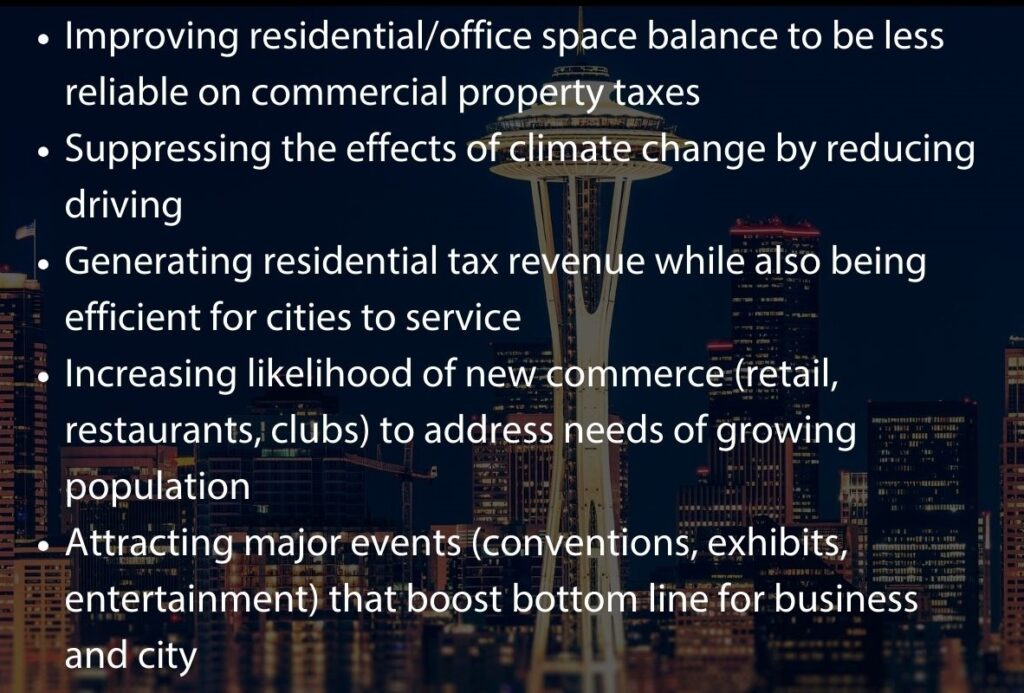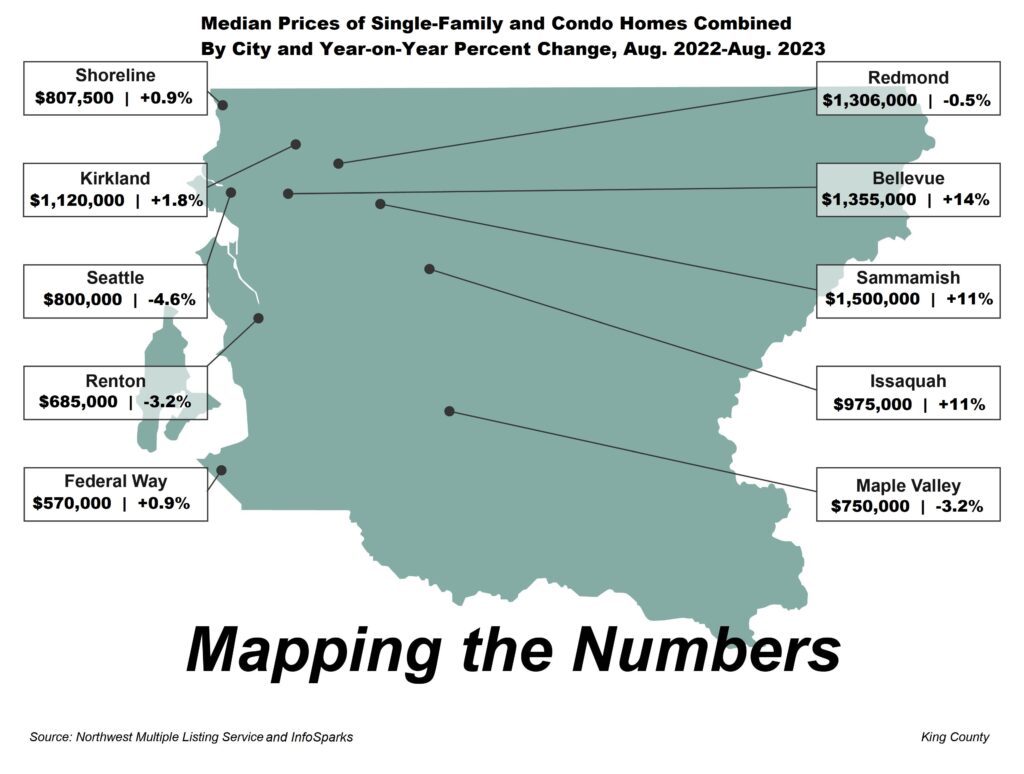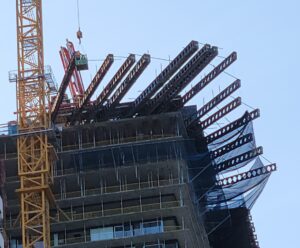
During an otherwise mundane annual physical, my doctor includes the usual reminders: Watch what you eat and drink, hit the gym and go for a walk every other day or so. He said something interesting at the end of his rinse & repeat suggestions about moving my feet: “This is a walking city, you know.”
Like most doctors when talking about medicine and healthcare, he’s right. Seattle is a good walking city.
A report from Smart Growth America and real estate info services firm Places Platform named Seattle one of the top five walkable cities in the nation. Portland was right behind us, with New York City at No. 1.
“The so-called ‘death of the city’ has been overstated … despite impacts from the pandemic,” said Christopher Leinberger, managing director at Places Platform, referring to the report. “These findings provide a strong economic base and cement walkable urban places and development as the wave of the future, as we move toward a more connected, environmentally sustainable way of life.”
The report found that 6.8% of the U.S. population is in walkable urban places – not as much as I thought. That represents just 1.2% of the total landmass of the top 35 U.S. metros studied. Just think if cities took positive steps to increase urban land use to, say, 6%. The report says cities that connect even more people to the benefits of urban living would “hold the keys to becoming a wealthier, more socially equitable society.”
Despite facing serious challenges – homelessness, drug addiction, gun crime – the Emerald City is starting to show areas of progress to boost urban appeal. City planners believe urban life works better when people, places and things are interconnected.
A century ago, the Denny Regrade flattened the hills between 1st Avenue in Belltown and Denny Triangle – a project that delivered huge benefits to getting around our city. A modern version of the regrade is taking place along the downtown waterfront (pictured above) with the addition of Overlook Walk, a breathtaking pedestrian bridge and viewing deck that will soon connect with Pike Place Market and other attractions downtown. (Here’s a blog post on the topic from last summer.)
In addition, discussions are well underway between city leadership, neighborhood advocates and developers to consider placing a “lid” over I-5. A concrete and steel cover connecting First Hill to downtown, for example, would reduce traffic noise, potentially add more parkland and encourage the construction of new housing. Philadelphia is in the process of widening an existing “cap” over the interstate that slices through the eastern edge of the city with amazing results so far.
It has been discussed in this newsletter the sharp decline in Seattle office occupancy; most recent stats show weekday worker foot traffic in downtown at 55% of July 2019 traffic, a figure that will likely increase – but by how much more? It only makes sense to seriously consider converting underserved office buildings with residential options. The benefits are innumerable, including:

It is not abandonment by workers of the cities that is of concern but affordability for potential residents. A report from the Brookings Institute described the issue as a lack of “shared prosperity,” as historically marginalized communities have been left behind during years of success and growth for many cities. The term “gentrification” connotes an improvement over the past, but the introduction of more expensive housing comes with the sad displacement of those who lived there for generations and runs counter to a city’s mission.
Steps to reverse this trend are moving forward to keep people of all stripes in their favorite areas of the city. Seattle’s Equitable Development Initiative is a good example. EDI funnels grant dollars to neighborhoods at high risk of displacement to empower local projects and improve educational opportunities.
The city this year awarded more than $13M through EDI to help support property ownership for more people. The funds invest in community organizations that will develop capital projects and permanent spaces for those in need.
Seattle also recently introduced a vision for south downtown, a historic area left behind compared with stunning growth elsewhere in the city. The vision includes a breadth of bold ideas:
- Prioritizing residential space over office use to cultivate more livable, vibrant neighborhoods
- Focusing on community connections between downtown and Pioneer Square, waterfront and Chinatown-International District
- Centering on equity and inclusivity to provide housing for all income levels
- Capitalizing on King County’s master planning process and relocating government facilities to free up city blocks for redevelopment
- And, closing off 3rd Avenue from motorized vehicles and repurposing it into a pedestrian/bicycle plaza that could feature retail, restaurants and entertainment.
Even faced with the most significant obstacle to progress this world has ever seen – the great pandemic – cities have, for the most part, endured and are now rebounding. Amid the societal challenges of today, it’s also vital to envision urban areas that are welcoming and better connected. Seattle is at least thinking and planning toward that goal.
BY THE NUMBERS
>> A survey of 2000 adults across the 50 largest U.S. metros showed 78% would be willing to pay more for a home in a walkable community. The National Association of Realtors® survey, published in July, noted 65% of respondents thought having public transport nearby would be “very” or “somewhat” important when looking for a home.
>> One in every 2044 Washington homes entered into foreclosure proceedings in the first half of this year, an increase of 16% from 12 months ago, according to information from ATTOM Data Solutions. That ranks 44th among U.S. states and the District of Columbia. Illinois was tops on the list, with one in every 397 homes experiencing foreclosure proceedings, a surprising 3.3% decline from a year ago.
>> Profit margins – the percent difference between median purchase and resale prices – on homes sold in Q2 rose to 48% in the U.S., a jump from 44% in Q1, according to ATTOM research. San Jose, Calif., enjoyed the largest raw profits on median-priced sales in the latest quarter, with a $600K average profit. Seattle was fourth in the nation with a profit of $285K.
>> Seattle is rated one of the most educated cities in the nation, according to a report from personal finance company WalletHub, which reviewed data from the U.S. Census Bureau and greatschools.org to reach its findings. The Emerald City is rated 9th in the nation for educational attainment and quality of education combined. Ann Arbor, Mich., and San Jose, Calif. were Nos. 1 and 2. Portland came in 16th and Spokane was 54th.
>> Seattle sits 10th among big U.S. cities for first-year homeownership costs, according to real estate site Point2Homes. New owners here spend an average of $232.5K on first-year costs, including a 20% down payment, closing costs, monthly mortgage, insurance and property taxes. San Francisco is the most expensive city for a first-timer, with total initial-year costs of $389.9K, with Fremont, Calif., only a few hundred dollars shy of that. Detroit has the lowest first-year ownership costs, averaging $25.1K.
>> Tacoma is one of the best places to live and move to, according to a study from Bankrate, which looked at criteria such as well-being, affordability, diversity and migration. T-Town ranks 3rd and offers low unemployment and affordable homes for our area. Austin, Texas, and Sarasota, Fla., topped the list.
SEPTEMBER HOUSING UPDATE
There is a feeling of Halloween in the real estate world because this housing market is a bit scary these days. At least that’s what some economists have expressed.
The market is spooking many potential buyers and sellers thanks to stubbornly high mortgage interest rates. The inability to loosen rates – and therefore reduce monthly payments on future home purchases – has put a stranglehold on sales activity in our area and elsewhere. Only buyers and sellers who must move are doing so.
Despite the “haunted house” vibe, prices are rising again and homes are only on the market for about a week across King County. What in the “pumpkin spiced latte” is going on here?!
“The number of shoppers out there is lower than there were over the last couple of years – but [the housing] supply has come down even more. It’s making the market feel hotter than it is,” said Ali Wolf, chief economist of U.S. building consultancy Zonda. “The few homes that are available are selling quickly and at or above list price.”
August’s figures in King County were in a narrowly mixed range compared with July. While there were 5.8% fewer new listings, the number of sales rose 1.7% against the previous month. Prices were flat to slightly higher since July.
Read a detailed assessment of our housing market in my most recent blog post: High Financing Hurdles Lead to Low Housing Activity in Seattle/King County
Looking at the county’s price map (below), the median value of all homes sold in August was (pardon the pun) all over the map. The typical price of a Bellevue home jumped 14% year-on-year while the price of a home in Seattle fell more than 4%.

This graphic – which you can click to expand – is presented every month, rotating among three home groups. Next month, we will look at single-family home prices by city.
CONDO NEWS
Turn your head toward the top of the high-rise project at 3rd Avenue and Virginia Street in Seattle’s Belltown neighborhood and you may find yourself unable to look away. The stray pieces of steel beams poking out by about a dozen feet over the streets appear to be a contemporary piece of art or possibly the beginnings of a massive bird’s nest.
What is it? It’s the beginnings of a residential first for the aptly named First Light. Atop the 47th floor tower, the super-luxe condo will feature a heated, outdoor, cantilevered pool. No other residential high-rise in the U.S. is believed to have one.
Among the other amenities: a fitness center, residents’ lounge, spa tub, meeting space, screening lounge, apple orchard, bike clubhouse with repair shop, and bike-share area, among other items. Wow, right?!
About 80% of the 459 units are Pending/Sold and the project is expected to open in stages starting early next year (timing TBC). Looking to tour the presentation gallery? Give me a call to arrange a meeting. (Pro tip: Always bring a buyer broker to represent you to a new construction site. The sales team represents the seller/builder.)
LUXURY LIVING
With autumn just around the corner, it’s not surprising to see fewer homes coming on the market. That’s especially true for luxury properties, which are typically the first segment of the market to hibernate as we near the end of the year. And that’s the case today, with only a few homes grabbing my attention.
We have this 6-bedroom, 5-bathroom, 6418 sq. ft., 1 ½-story home with basement in Redmond. I think you will love how this estate not only brushes up to Lake Sammamish with 94 ft. of beachfront, but also overlooks the expansive Marymoor Park. (I know, right?!) The seller reportedly describes the home as “Cape Cod meets the Northwest.” Hardwood floors, farmhouse-inspired chef’s kitchen, outdoor terrace, waterfront balcony off the main bedroom, wine cellar and much more – everything one would need to live a splendid life. List price: $8M ($1246/sq. ft.).
Further afield, introducing a 4-bed, 3.25-bath, 7581 sq. ft., 2-story log home with basement in Seabeck, Kitsap County. The living space with 38 ft. ceilings and rock fireplace is jaw-dropping. The theater with stadium seating is big and comfy. The 4000 sq. ft. shop includes space for all types of pursuits and pleasures. The inspiring video touts all of the property’s beauty. List: $6.85M ($904/sq. ft.) – a bargain compared to King County luxury homes.
We wrap up this month’s tour of standouts with a one-of-a-kind condo in West Seattle. This 3-bed, 2.5-bath, 5652 sq. ft. residence offers forever views from its second-floor perch looking northwest onto Elliott Bay. If owners don’t wish to work in their chef’s kitchen, then perhaps they will walk to the ground-floor Cactus restaurant. The home comes with a thousand-bottle wine room, back garden and massive 2500 sq. ft. patio with expansive water views. The light-filled residence was once home to Seattle lawyer, opera singer and UW sports fan Melvyn Poll. Shoreline meets sophistication in this hidden jewel on the Alki coast. List: $3.995M ($707/sq. ft.).
What else is happening in and around your Seattle?
Wine Not!, Sept. 17
Twenty restaurants are featured along with a beer garden at Bite of PhinneyWood – a blend of Phinney Ridge and Greenwood (but you probably already knew that!). The fun, which was a sell-out in 2022, takes place at Phinney Center (6532 Phinney Avenue North). 1-5pm
Oktoberfest, Sept. 22-24
Seattle and the Eastside offer a take on a fall classic. Fremont Oktoberfest is expected to have one hundred types of beer and cider, along with food and bands at Bold Hat Productions (3503 Phinney Ave.). Friday, 5-11pm; Saturday, 12-11pm; Sunday, 12-5pm (the day when your pooch is welcome for Dogtoberfest). And, Kirkland Oktoberfest will offer beer, sauerkraut, bratwurst, costume contests, games, live music (Friday, 4-11pm; Saturday, 12-11pm; Sunday, 12-6pm), and a wiener dog race (Sunday, 1pm) at Marina Park (25 Lakeshore Plaza). Except for the wiener race, both venues are for 21+ only.
Halloween Festivities, Sept. 22-Nov. 4
Spooky fun is just around the corner at Seattle’s popular haunted house – the Georgetown Morgue (5000 E. Marginal Way S.) And, Stalker Farms (8705 Marsh Rd., Snohomish) has two walk-through haunts (voted top fan favorite in the state), a zombie shooting gallery, nighttime corn maze and beer garden. Sept. 30-Oct. 29 only. Recommended for 12+. Various times.
Lantern Parade, Sept. 23
Celebrate the equinox with lanterns, glowing costumes and music at the Luminata parade of lights. Begin at Green Lake Aqua Theater on West Green Lake Way N. at the south end of the lake, and then walk with the parade to the Bath House to the north. Free. 7:30-9pm.
Free Day at the Park, Sept. 23
Entry is free at Mount Rainier, Olympic and other national parks, as well as for any of the 140 Washington state parks on this day when daylight and darkness are exactly 12 hours in length. Get out and enjoy!
Tea Party, Sept. 23-24
Sample fine tea, attend presentations by tea authors and experts, and shop for the finest aromatic leaves at the Northwest Tea Festival. It’s all brewing (Did you see what I did there?) in Seattle Center Exhibition Hall (301 Mercer St.). Free for children under 12. Saturday, 10am-6pm; Sunday, 10am-4pm.
Mariners Postseason Push, Sept. 25-Oct. 1
Local baseball fans are watching intently as the Mariners inch toward their second straight postseason appearance – we hope! Seattle hosts a pair of division foes, the Astros and Rangers, to wrap up the regular season and with everything on the line. Tickets. The M’s, Seahawks and next month the Kraken: What a time to be a sports fan in Seattle!
All That Jazz, Oct. 4-Nov. 5
If jazz is your jam, then you will be in heaven over four weeks with two music celebrations. Top national and regional jazz musicians – including Pearl Django with Gail Pettis – will appear at the Bellevue Jazz & Blues Music Series (Oct. 4-8). Among the venues: Meydenbauer Center (11100 NE 6th St.). The event overlaps with the Earshot Jazz Festival, which will feature dozens of concerts, plus films on jazz at various Seattle venues.
Film Festivals, Oct. 12-29
We love our film fests! Two take place in the coming weeks. Seattle Queer Film Festival (Oct. 12-29) begins with a reception and after-party on opening night and will showcase feature films and shorts in seven theaters and online. The Seattle Polish Film Festival (Oct. 13-22) screens more than a dozen titles at SIFF Cinema Uptown (511 Queen Anne Ave. N.).
Going Green, Oct. 14
Green Building Slam has 10 brief lectures by innovative architects and builders, followed by networking at Town Hall Seattle (1119 8th Ave.). 6-10pm
Events are subject to change. Please check with venues to confirm times and health-safety recommendations.
In case you missed it….
The Living the Dream blog over the last several weeks dove into two areas of homeownership that are at the opposite ends of the spectrum – preparing to finance a home and the potential for losing the property over a failure to pay the mortgage.
Here are the headlines:
What Information Will My Mortgage Lender Need?
Down Payments: Bigger Isn’t Always Better
Short Sales – Rules of the Road
Foreclosures and Sheriff Sales in King County – What You Need to Know
As you can see, I love to educate my readers to make them smarter as they embark on a home purchase or sale. Let me know if there is a topic that you wish to learn more about. I will consider researching it for the blog.
Do you enjoy reading my monthly newsletter? You must if you’re all the way down here! Please consider forwarding this email to friends or family members. Or share this link to have them sign up to receive the mailing each month.
Thanks for reading!




